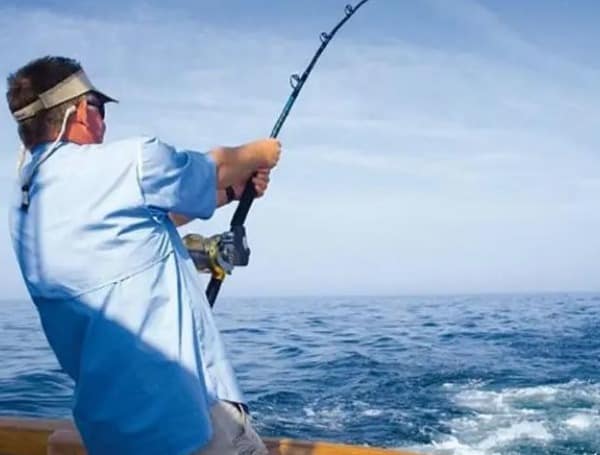By Guest Columnist Kenneth Reaves
When learning the ropes — and rods — of saltwater fishing, thorough preparation involves more than just a rich arsenal of gear and the appropriate attire. Open-water fishing is challenging and requires technique and prior research.
If you’re embarking on an open-water adventure for the first time, keep the following saltwater fishing tips in mind.
Research Your Destination
The key to discovering a spot rich in saltwater fish is ample research. At least a week before your trip, you’ll want to read up on fishing reports, tide charts and weather forecasts.
For instance, while a rainy morning might deter most anglers, it can also surprise you with better catches — if you know where to look.
Some areas are more crowded with fishing enthusiasts during different times of the year. Consider whether you are traveling in the spring, summer, fall or winter and do the appropriate research. You can get some ideas of where to go at MyFWC.com/Marine by clicking “Where to Saltwater Fish.”
Think About Your Target Species
The type of catch you’re after will dictate where you anchor your boat. Targets, such as yellowfin or other tunas, for instance, are surface feeders. Thus, you’ll want to be on the lookout for weed lines and baitfish breaking the surface.
On the other hand, some species including groupers and snappers are bottom feeders and prefer structures including reefs and wrecks. Angling for these species can require special equipment, such as a fishfinder, circle hooks, dehooking tools, descending devices and more. MyFWC.com/FishHandling explains much of this fishing gear.
Stay up to date on the latest regulations for saltwater fishing at MyFWC.com/Marine by clicking “Recreational Regulations” or by downloading the Fish Rules app on your smart device. Learn about fish identification at MyFWC.com/FishingLines or by visiting MyFWC.com/Marine by clicking “Fish Identification.”
Use a Bathymetric Map
When it comes to open-water angling, you can never underestimate the usefulness of a map. Bathymetric maps are a type of underwater topographic map that indicates specific depths. Space between lines on the map illustrates whether an area is close to a steep slope, drop off, flat or shoal. Lines that are close together indicate a rapidly changing depth in the area.
Keep in mind that bathymetric maps can be challenging to find at your local angling shop. If you have trouble coming across a bathymetric map, you can rely on other tools, such as nautical charts or satellite images.
Speak to the Locals
While ample internet research might suffice, nothing quite compares to gathering input from local anglers. When you have a specific target species in mind, drop by the local bait shop for advice. Or join an online group focused on fishing in your area of interest.
Some angling hot spots have knowledgeable fishing guides who can direct you to the ideal area for your specific catch. Hop on a trip for a chance to see the area up close with an expert who can teach you how to catch your target species.
Alternatively, you can venture out into the ocean yourself and observe where other anglers are setting up shop. Just be sure to mind your distance and not crowd other anglers. Learn more about angler etiquette at MyFWC.com/Marine by clicking “On-the-Water Etiquette.”
Make the Most of Angling Technology
Nowadays, you won’t find any shortage of state-of-the-art angling technology available online and at your local bait shop. Make sure that a reliable fish finder is part of your staple arsenal.
Fish finders use sonar to locate fish within your chosen area. When an echo transmits back to your device, it indicates the presence of fish immediately under or around your vessel. Some wireless fish finders are Bluetooth compatible and will quickly pair with your Android or iOS device.
You’ll want to consider other staple needs for open-water fishing: GPS, VHF 2-way radio, flares, noise-making device, first aid kit, and life jacket for each person on board. Wearing a life jacket while on the water is a simple way to prevent you from drowning if you fall overboard due to a boating accident. Learn more about boating requirements and safety at MyFWC.com/Boating. Find more tips and tricks at MyFWC.com/Marine by clicking “How to Saltwater Fish.”
The Bottom Line
If you have recently taken an interest in saltwater fishing, knowing how to target your intended catch will go a long way in the open water. Make the most of your day out by researching your destination beforehand, coming well-equipped, and learning how to identify different kinds of saltwater fish. Consider sharing your catches with scientists through the iAngler app and submitting catches for recognition at FWC’s CatchaFloridaMemory.com.
About the Author
Kenneth is an expert at saltwater fishing and the founder of Perfect Captain. He has been angling for over two decades and hopes to provide accessible resources for fishing rookies and veterans.
Android Users, Click Here To Download The Free Press App And Never Miss A Story. It’s Free And Coming To Apple Users Soon.
Support journalism by clicking here to our gofundme or sign up for our free newsletter by clicking here
